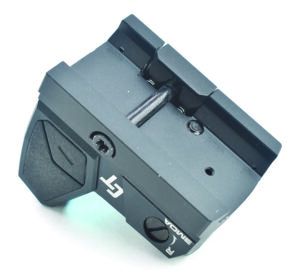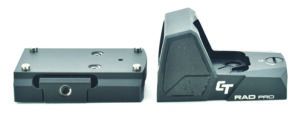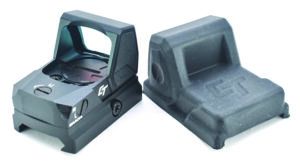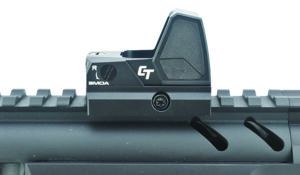We presented test results in the March 2020 issue about everyday-carry pistols with slide-mounted red-dot sights. As a result of that piece, Gun Tests readers sent in requests asking for more information about the new sights. When you ask, we try to deliver, so we hit the topic a second time in the November 2021 issue. Questions about still more additional optics followed immediately, though our responding readers seemed to be particularly interested in the Holosun brand. So get in, sit down, and hold on because we have new dope on four more sights for you, including the new Holosun AEMS (Brownells.com, 100-043-828WB, $399), Lucid Optics M7 (OpticsPlanet.com, $215), the Swampfox Justice model (Amazon.com, $235), and the Crimson Trace Rad Pro (MidwayUSA.com, $280).
We tried to keep the same testing format we used for the previous tests. Then we remembered the frustration we had with mounting systems for pistols, but still wanted to test the sights in a competition arena. We also wanted to see which products were flexible enough to be mounted on different platforms. So, we grabbed a SIG MPX 9mm that we use for USPSA Pistol Caliber Carbine (PCC) division and started shooting. We sighted in each red dot in turn, then shot them for feel and function at American Shooting Centers in west Houston. We shot the carbine/optic combo in practice for about a month and then finished everything off with a USPSA match. Observations were recorded at each step along the way. We still had a stash of Remington 115-grain 9mm ammo we were able to use for the tests.
Along with the factors we tested for in the past, we wondered if the “dot and a donut” reticle from the Holosun or the simple red-dot reticle like on the Swampfox would be faster. To see, we set up an “A Zone” plate (approximately 6 by 11 inches) at 9 yards and did one-shot drills from USPSA ready (port arms with the buttstock resting on the belt, safety engaged, and finger off the trigger). The differences were statistically insignificant — less than 0.02 seconds on average. Pick the reticle/body style you like and practice, practice, practice.
Our SOP has been to mount low- or zero-magnification optics well forward on the Picatinny rail. Just for giggles, we mounted various optics all over that mount — forward, middle, and rear. We decided, very subjectively, that we liked our existing practice and settled for mounting the red dots as far forward on the rail as possible while still keeping them actually attached to the receiver. We felt this method allowed us to focus on the reticle most quickly with both eyes open. It also seemed to allow us to point the carbine more naturally and helped us find the dot.
We understand that these manufacturers established their mount height with a different goal in mind than what we had in these tests. We were running the red dots on a competition-type pistol-caliber carbine in a United States Practical Shooting Association setting. We were looking for high-speed no-drag red dots that were easy to acquire and fast to use. The makers of our sights were generally trying to allow more defensive-minded users to co-witness their back-up iron sights through the lower parts of the dot windows in case the optic failed. Smart — and we don’t disagree with the concept at all. We just really liked the option to bring the sight to a lower level, which allowed us a more secure cheek weld. Lucid supplies its dot with multiple-height mounts, and Swampfox has a lower mount available on its website.
So with those fine points covered, we went to the range and shot these sights side by side.
Gun Tests Grade: A-
$280
We included the Crimson Trace CTS 1250 in our first review, liking what we saw. Then we heard about CT’s next-generation red dots being introduced in the guise of the RAD (Rapid Aiming Dot), so we had to try it. This RAD Pro is a full-size dot made for a full-size pistol (or carbine/rifle). It will obviously fit any firearm cut for a CT RAD footprint, which also happens to match the very popular Docter pattern. Ours came equipped with an optional low-profile Picatinny mount allowing the RAD Pro to be installed on our MPX. The Picatinny rail adapter uses four studs on the top side to fit into recesses on the underside of the sight. This allows the sight body to absorb the recoil forces, instead of relying on just the mounting screws. The Pic rail mount where it interfaces with the actual rail is held on by a relatively short clamp and a single screw. This could be a weak point but didn’t affect anything we did.
| Weight | 2.2 oz. |
| Length | 1.84 in. |
| Width | 1.19 in. |
| Dot Size | 3 moa |
| Height Above Rail | 0.130 in. |
| Sight Window | 0.95 x 0.6 in. |
| Mount Type | Picatinny rail adapter – 1 screw |
| Battery Type | CR1632 |
| Battery Change | Slotted screw on top deck |
| Estimated Battery Life | 20,000 hours |
| Control Location | sides and top |
| Warranty | Limited lifetime |
| Telephone | (800) 442-2406 |
| Website | CrimsonTrace.com |
| Made In | China |

The CT RAD Pro has a simple 3-minute-of-angle (moa) dot that impressed us. The RAD Pro comes with an ambient light sensor that automatically adjusts the dot’s brightness to surrounding light conditions. There are a total of eight daylights levels and two more suitable for night vision. In carry mode, we would probably be leaving things alone and let the sight do the work for us. But sights don’t always do exactly what we want, and a manual override is available just in case you want that really bright dot in the next stage of fire.

Crimson Trace upgraded the power-supply management with a couple of features. If the sight remains motionless for two minutes, the dot turns off to conserve battery life. The onboard CT Motion Sensor detects any movement and immediately turns the sight back on. If someone manages to keep the sight moving constantly for eight consecutive hours, an auto shutoff feature kicks in to power the sight down as well. Manual overrides can always turn the sight back on. The combined result is battery life estimated at 20,000 hours, or about two years. The RAD Pro uses a CR1632 lithium battery that loads into a compartment on the top deck. The cover is slotted and easy to unscrew — not too easy. On/off and brightness controls are located on the left and right sides of the window. The windage-adjustment screw is on the right side-rear, and the elevation adjustment is at the rear of the top deck. Controls were easy to access and intuitive. A rubber-type slip-on cover is provided for additional protection.

With a width of 0.95 inch and height of 0.60 inch, the window is large enough to provide a good field of view. It is recessed to help prevent damage. Even the top strap has been re-engineered to help deflect force away from the window in case the sight is dropped. To help a bit more, this sight is waterproofed to a rating of IPX7. That means it should hold up being immersed to a depth of 1 meter for more than a few minutes. Don’t try this at home, please.

We had testers for this group of sights running from a 245-pound man down to a petite 14-year-old young female shooter, so faces and sizes differed quite a bit. For the largest man, the section of Pic rail that comes with the RAD Pro was a welcome add-on, just a touch short, though still usable. With our normal shoulder mount, the dot just appeared high in the window. Another 3⁄16 to 1⁄4 inch taller or an additional section of Pic rail would have been nice. For the young lady who shoots this particular carbine in United States Practical Shooting Association competition, the sight was at a perfect height.
Our Team Said: Brightness of the dot was very good, with the dot itself being well-defined and clear.





























